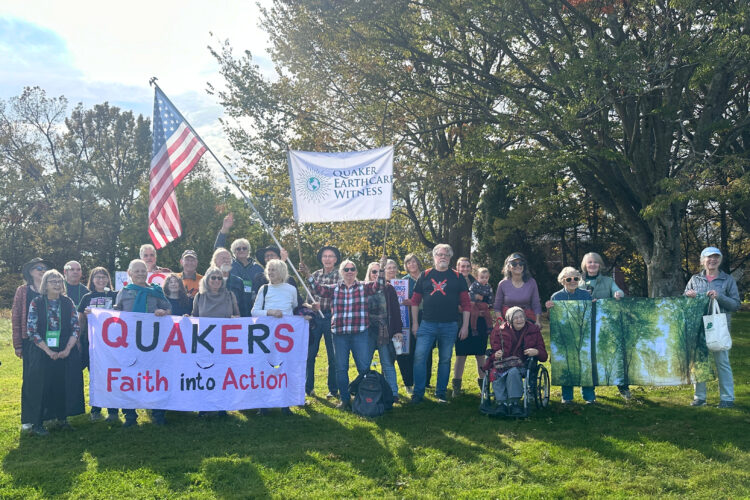When Will We Wake?

Much has been written about the dangerous, destructive, and morally untenable practice of hydraulic fracturing for natural gas. Many Friends would agree it’s time to stop such practices that are violating Earth and switch to sustainable sources of energy—wind, water, and solar. Yet after all we have learned about the ill effects of extreme extraction—from an outright assault on our democracy, freedom of speech, property rights, human and ecological health—plus all we know of the beauty and integrity of the natural world, Friends for the most part are still sitting on the sidelines.
What is the source of Friends’ failure to take corporate action on behalf of the planet? Why are Friends still so reluctant to take a stand in the face of the literal evisceration and shattering of our larger body—Earth—through hydraulic fracturing?
The answer is not in a lack of knowledge. Friends are, I believe, quite cognizant of the problems—or they could be. The Quaker Earthcare Witness discussion listserv provides an endless stream of news on the growing concerns and coming ravages of climate change, overpopulation, genetic engineering, hydrofracking, tar sands strip mining, and more.
Albert Einstein said, “Those who have the privilege to know have the duty to act.” Why, then, do so many Friends continue to shirk this grave responsibility?
To unblock the floodgates to action, we must first examine our unconscious fears and the errors in our thinking.
Causes for Inaction
In my search for answers, I found that the most likely causes for inaction—both Quaker and non-Quaker—can be explained in the writings of Quaker activist George Lakey and eco-theologian Thomas Berry.
As I have investigated these two seminal thinkers, and as I have searched my own heart, I have come to believe that most Friends do not take action beyond our personal realms (what George Lakey calls “earning Quaker merit badges by personal lifestyle choices rather than asking how much difference one is making in the movement’s struggle for macro-level change”)2 because of a fundamental confusion about our true identity as Homo sapiens (a cosmological question) and the unconscious limitations imposed by Friends’ respective social class (the domain of social science).
The primary error in our thinking, it seems to me, lies in the misconception that we are somehow separate from or “above” Earth and all its life. As I wrote once to explain “why I care” to a group of Westchester Friends, “If you consider yourself separate from Earth, from Gaia, the being in whom we live and move and have our being, then confusion sets in when you see Earth in peril. But if you feel yourself to be part of the organism, of the larger being called Earth, it is a matter of self-care to want to preserve the beauty and well-being of the planet.”
An excerpt from a Buddhist Ceremony for Ecological Regeneration illustrates this inseparability in a highly evocative manner:
With heart and mind open, I see that there is no separation between my body and the body of the Earth. Every mineral in this flesh and bone has been stone and soil and it will be again. Looking into one calcium molecule in my bone, I can see that it used to be part of the body of a green leaf. Before that, it was part of the living soil in a garden. Long before that, it was a shell in the sea. I see the continuation of this calcium molecule in so many forms and now in my bone. I can see that the earth element in me will return to the soil and manifest as other forms of life in the future.
. . . With tenderness and love I bring my awareness to the suffering that is present in this collective body. I see the mineral element that is stone becoming soil becoming vegetation becoming flesh and bone becoming soil again. I also see the suffering that is present in the mineral element. I see the toxins we have made creating sickness and cancer in living beings, and the pesticides and fertilizers poisoning the soil. I know that the suffering of the mineral element is my suffering. I embrace this suffering with tenderness and love. [Source: Ambrose. Desmond. “Touching the Earth for Ecological Regeneration.” Used by permission.]
My query deepened: What is the source of this sense of separation that pervades our religious society and society at large, that keeps Friends mostly silent and immobile in the face of the poisoning of our planet? I noted that Friends were able to step up to the plate when the immorality of slavery finally became clear. What, then, makes the destruction of the Earth—the living host of all we know, the very source of the next breath we take—somehow less offensive in the eyes of Friends?
A major cause is species-centered narcissism, also known as anthropocentrism. In his Schumacher lecture “Every Being Has Rights,” Thomas Berry proclaimed that our love had become too narrow. “It has been narrowed to the human instead of including the whole of the universe, as it once was in the Christian teaching.”
We contend not only with our radical discontinuity with the rest of Creation. We are also unconsciously bound by our class distinctions. In his article for the January–February 2012 Quaker Eco-Bulletin, George Lakey writes that, “middle class culture supports fitting in, being restrained. It was hard for nurses and teachers historically, to form unions, because they didn’t want to appear ‘unprofessional’ in the eyes of the world, since ‘professional’ is performed by appearing smooth and not making waves. . . . Quakers who stay in their middle class bubble guarantee the ineffectiveness of which they complain.”
His words awakened something in me. I reached out to George to find out more. He explained that “no amount of consciousness-raising or discussion can ever take the place for Quakers of getting their bodies out of the chair and in motion, outside their comfort zone, taking a stand. One reason why a vigil is a waste of time for Quakers these days is that it is a ritual—the kind of ritual that early Friends scorned when they saw Anglicans doing it. Friends need to act, in situations of uncertainty, where they are slightly out of control, where nicely phrased locution is not the currency.”3
In light of this new awareness, never having been a student of social science and belonging to the middle-to-owning class myself, it was interesting to consider my own resistance to nonviolent direct action. More burdensome, as a victim of child abuse I had no desire to ever again be a victim of “the Man” by getting myself arrested and perhaps being helpless and abused with no way out. Yet I understood how facing my worst fears might redeem a lifetime of conflict avoidance. The answer, George told me, is to keep remembering, “I am not alone. Others will help me,” contradicting the message from my class background.
In contrast to the middle-class tendency to shy away from conflict, early Friends embraced and cultivated it. They used conflict to create a stir, to bring injustice into the light. Quaker history is full of examples of conflict cultivation, from women’s suffrage, to civil rights, to the abolition of slavery.
This conflict aversion affects not only many Friends but middle class environmentalists as well, including the class of big name environmental organizations that veteran organizer Bill Moyer, the author of Doing Democracy (a handbook of essential reading that maps the structure of successful social movements), calls “Professional Opposition Organizations.” George Lakey explains: “Even with the cliff edge of climate change staring middle class environmentalists in the face, most are reluctant to return to the strategy used in their biggest U.S. victory, which they won against all odds, the 1970s nonviolent direct action campaign against nuclear power.”
In recent times we’ve learned that a number of established environmental advocacy groups have compromised what they stand for, quite possibly to avoid the conflict that inevitably will emerge if we act to safeguard Earth’s living systems from the ravages of tar sands strip mining, nuclear energy, hydraulic fracturing, deep-water drilling, mountaintop removal, and genetic engineering. The most recent example to come to public awareness is Sierra Club’s acceptance of $25 million from Chesapeake Energy, one of the largest gas drillers in the world. A further investigation of this capitulating trend can be found in the article published in The Nation in 2010, “The Wrong Kind of Green” (http://www.thenation.com/article/wrong-kind-green#).
Resources for Friends
We must each examine where we are unwilling to make waves, when our consciences dictate it’s time to move our bodies “out of the chair and in motion, outside [our] comfort zone, taking a stand.” However, George offers us not only his critique but also uplifting solutions: “Brought up owning class? Great—bring the gifts (vision, big picture, aesthetics) often cultivated in the owning class, and let go of the isolation and need to control. Brought up middle class? Great—bring the gifts (optimism about making an individual difference, process skills, articulateness) and let go of both the obsession to fit in and conflict aversion. Brought up working class? Great—bring the gifts (directness, passion and willingness to fight) and let go of the deference to ‘superiors’ and the old label of ‘ignorant.’” He assures us there are guidebooks to help us learn to work together. He cites Betsy Leondar-Wright’s book Class Matters as abundant with quotes and anecdotes. He also tells us that Linda Stout, who comes from many generations of Quakers, now leads the organization Spirit in Action and that her book Bridging the Class Divide is a great source of inspiration.
For more about the gifts and limitations of class conditioning, you can view George Lakey’s 2011 William Penn Lecture, “Powerful Beyond Measure: Trusting the Call to Leadership”, at http://bit.ly/JzgPL9.
There are many more resources for Friends. For more about the Quaker tradition of cultivating conflict, listen to George’s FGC 2011 plenary address “Conflict as a Gift of the Spirit,” where he discusses the specific power of conflict to transform and bring about positive change in our society. Another is “New Theory, Old Practice: Nonviolence and Quakers,” George Lakey’s Southeastern Yearly Meeting 2004 paper, which also discusses the most powerful (though slightly rusty) tool in the Quaker toolbox for social change. Then there’s the organization Training for Change and the online blog/journal Waging Nonviolence. Finally, there’s the amazing Global Nonviolent Database at Swarthmore College: http://bit.ly/J3jeLx.
In the struggle for ecological justice, which is integral to human justice, we have now seen the victims’ faces. We see victims from 34 states across the US and around the world, animal stillbirths, destroyed land values, air pollution in Wyoming, the industrialization of the beloved landscape. Friends are needed in this struggle.
In closing, I leave you with the words and final query of Christopher Frye in his poem “A Sleep of Prisoners:”
The human heart can go the lengths of God.
Cold and dark we may be, but this
Is no winter now. The frozen misery
Of centuries cracks, begins to move.
The thunder is the thunder of the floes,
The thaw, the flood, the upstart Spring.
Thank God our time is now, when wrong
Comes up to face us everywhere,
Never to leave us till we take
The longest stride of soul we humans ever took.
Affairs are now soul size,
The enterprise is exploration into God.
Where are you making for? It takes
So many thousand years to wake,
But will you wake for pity’s sake!
—Christopher Frye, A Sleep of Prisoners

